For the island of its size, Naxos still seems to be a well-kept Greek secret. Paros, which dominates the lists of the world’s best islands and attracts celebrities such as Tom Hanks and Salma Hayek, often overshadows its modest neighbor. But Naxos is certainly a destination to count on! The island offers a vast array of places to visit and things to do. This can easily make your vacation week feel too short! With no time to waste, visitors do need some guidance. For those who want to discover one of the most rewarding islands in Greece, we’ve composed a list of the 17 best things to do in Naxos!
Whether you’re up for laid-back vacations on the beach or active holidays that include hiking to the highest peak of the Cyclades, Naxos Island will provide things to do
As the largest island in the Cyclades archipelago, Naxos rarely feels overcrowded. It lets every visitor explore a corner of one’s own. Naxos attractions range from important historical sites to places of natural beauty.
Whether you’re up for laid-back vacations on the beach or active holidays that include hiking to the highest peak of the Cyclades, Naxos Island will provide things to do. Explore its mythology in the cave where Zeus was raised, learn about architecture in its ancient temples and newer churches, visit museums and art workshops, do sports in an amazing setting, or opt for restaurant hopping as an activity of choice!
The sightseeing options in Naxos could feel overwhelming for short stays. So choose the pace that suits you, and make the list of must-see places according to personal preferences!
The Greek island where Zeus, the king of gods, found refuge from the rage of his father, is a place where many of us could retreat to. Being the land of marble and myths, Naxos could construct some legendary holidays for a variety of travelers!
Rent a car, hop in, and start exploring the island of Naxos!
Top 17 things to do in Naxos, Greece
1. Find the best beach in Naxos
Naxos beaches are maybe the island’s most famous asset. With kilometers of sand stretching over its southwestern coast, most beach lovers end up exploring this area. It is not unusual they often end up on the top of the lists of things to do in Naxos.
Alyko beaches
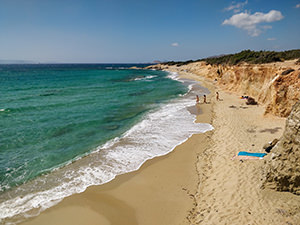
For my taste, the prettiest beaches are located on the Alyko (or Aliko) peninsula. Just where the dirt roads replace the paved ones, this secluded corner of Naxos opens to the scenic wilderness. It is a protected natural area covered by the largest Greek cedar forest.
Kedros Beach (reserved for nudists) and Hawaii Beach (just next to it, with a 10-meter drop from the dunes to the sea level) look stunning. But they are also exposed to the northern winds and stronger waves. For better protection, visit the popular southern coves called Alyko Beach and Mikro Alyko Beach.
While special unspoiled beauty emanates from these white soft sand beaches and their azure waters, there is not much infrastructure. Forget the toilets, shops, sunbeds, or parasols! The nearest hotel is actually the abandoned one, still worth visiting though – check the recommendation no. 14!
Agios Prokopios
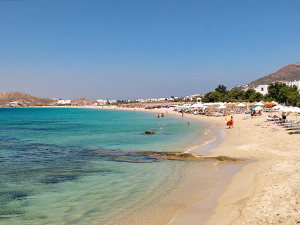
If you cannot do without civilization, the best beach in Naxos in your case could be the blue-flagged Agios Prokopios. The golden sand here is thick and stretches over 1,5 kilometers.
The northern area of the beach is not developed so it attracts fewer crowds. The part closer to the town abounds with shops, restaurants, bars, and some water sports facilities – check the recommendation no. 2!
Saint George, Glyfada, Plaka, Agia Anna, Psili Ammos
There are more beaches worth exploring in Naxos. If you don’t want to go far from Naxos Town (Chora), the closest one is Agios Georgios / Saint George Beach. Its waters are shallow, which is perfect for families with young kids.
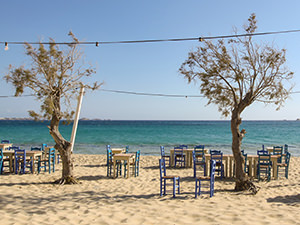
Just north of Alyko Beach, you can enjoy the sand dunes of Glyfada Beach! Even more famous dunes you will find at Plaka Beach, a 4-kilometer-long white-sand promenade. Its southern end, as well as the Agia Anna Beach south of Saint Nicolas Chapel, are popular among naturists. When you get to the chapel, find the shark-shaped rock for a fun photo opportunity!
On the eastern side of Naxos Island, the beach next to the Kanaki village is eponymous with ‘fine sand’. Psili Ammos is a lovely oasis of sand dunes, cedar forest, and clear waters.
2. Go scuba diving in Naxos with Blue Fin Divers
Agios Prokopios is not just a nice place for lazy beach days; it is also a departure point for some fantastic active holidays in Naxos!
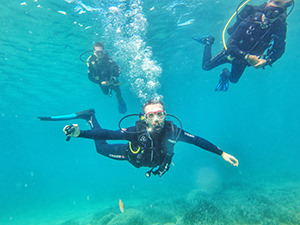
The sea around the island is rich with natural wonders and civilization leftovers. This makes it an ideal location for snorkeling, freediving, and scuba diving. One can discover sea caves and reefs, but also wreckage sites teeming with marine life. In waters around Naxos, you can look for the plane wrecks from the Second World War, such as the torpedo bomber Bristol Beaufighter or German Arado seaplane. But there are also sunken ships such as the impressive Dutch vessel Marianna which finished its cargo shipping career in 1981!
Blue Fin Divers is a diving center at Agios Prokopios Beach that can organize these and other enriching scuba diving excursions for you! They offer PADI-certified training programs ranging from the Open Water Diver to Dive Master.
However, there is also a Bubble Maker program for kids, as well as a Discover Scuba Diving program for absolute beginners. I went through this introductory course that practically enabled me to experience my first dive with full equipment on seven meters of depth in just 2.5 hours!
The Discover Suba Diving program costs 60 Euros. If you want to experience one of the best things to do in Naxos undersea, you can do it with Blue Fin Divers from May till October.
Scuba diving astronauts in a rewarding universe
Panagiotis Niflis is an experienced diving instructor with two decades of professional love for the underwater. First, he provided personal instruction in the theory of scuba diving, which was both educational and fun. Then we put our wetsuits on and crossed over the beach full of bikini-clad observers.
With the heavy equipment, I walked proudly through the soft sand. I tried my best to look professional, and at least not trip over before I reached the shallow water. My first steps towards weightlessness really felt like embarking on an astronaut’s mission. Okay, with no countdown, applause, and live media reports.
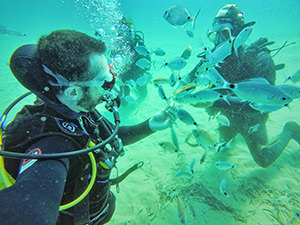
After initial training in the shallow water, we slowly floated away into grander depths. Breathing underwater was an intense experience and one needs to approach it with utter respect. In mostly white sand surrounding, with several fun stops arranged by the dive center, such as an underwater bicycle, an abandoned toilet bowl, or a feeding spot for some colorful local fish, one could easily lose the sense of orientation. But with the vigilant eyes of Panos, and his Bulgarian assistants Aleksandra and Viktor, exploring the unknown Naxos universe seemed a reasonably safe thing to do.
After this basic introduction program, one could easily decide if scuba diving was for him/her or not. There were three of us about to dive that day. One did give up after the initial training in the shallow water.
For those who bravely stayed until the end of the basic course, scuba diving brought a real risk of becoming addicted. Especially with so many tempting baits in clear Naxos waters, plane and shipwreck sites, rich sea flora and fauna, one could easily trade the earthly pleasures of sun tanning on the beach for the otherworldly trip to Naxos below the sea level.
If you don't want your underwater photographs to be in blue and green tones like mine, learn what to do in our guide to underwater camera housings!
3. Surf the windswept beaches
There is a reason behind so many windmills built on the Cycladic Islands. Some of these monuments to Naxos winds are old, some are new. The modern wind turbines are located in the northeastern part of the island, while on Vivlos hills one can find three ancient windmills.
From May till September, Etesian or Meltemia winds blow over the Aegean Sea. These dry northern winds can be dangerous for sailors. But due to their steady nature in the afternoon hours, the passionate Naxos kiteboarders and windsurfers exploit them for their water sports.
Kite surfing on Mikri Vigla Beach
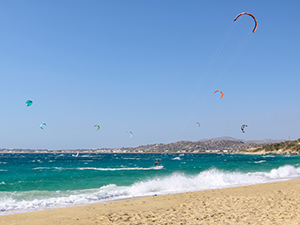
Mikri Vigla and the connected Orkos Beach may not be ideal for tourists looking for casual swimming. But if you like resting your eyes on kite surfers flying over the waves, these are the best Naxos spots to visit. The Meltem winds produce low rolling waves on Kastraki Beach / Sahara as well, so that’s another location worth visiting if you are a fan of this sport.
Windsurfing in Laguna
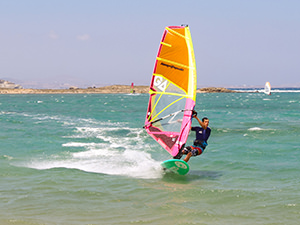
Laguna Beach, just north of Naxos Airport, is a favorite spot for windsurfers. They come from all over the world to power their sails in this wide shallow bay, making it one of the most popular windsurfing destinations in Greece. If you come just to watch, try to pair it with the air traffic at this not-so-busy airport. That way, you might even steal a selfie with an arriving/departing plane! Check Naxos Airport’s live schedule here.
4. Visit Portara – the Temple of Apollo, or – Dionysus?
Portara or the Great Door is a massive marble frame standing on the islet of Palatia, just by the main Naxos port. In ancient times, the land was connecting the two hills. After the rising of the sea, they constructed a causeway for easier access.
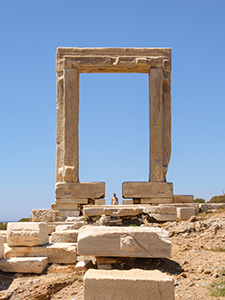
This monumental doorway is 6 meters tall and 3.5 meters wide and is a lonely remnant of a larger temple built during the reign of the Naxos tyrant Lygdamis, in the 6th century BC. The ambitious ruler had a grand vision of a temple that would outshine the Zeus Temple in Athens or Hera’s Temple in Samos. But then the war with Samos required resources and the construction was stopped abruptly.
In the Middle Ages, Christians erected the church over the ruins, but even that building did not survive. The marble was used in the construction of Kastro (the Castle of Naxos) – see recommendation no. 12. Portara survived only because it was too heavy to dismantle; each of its columns supposedly weighs 20 tons!
A choice to build the entrance to an Ionian-style temple on the western side of the island was unusual, therefore it could have been intentional. The fact that Portara is facing Delos, the mythological birthplace of Apollo, could mean that the temple was dedicated to the most beautiful of Greek gods.
But some think that Portara was an entrance to the temple dedicated to Dionysus, the wine god, and patron of Naxos. Right after he had killed the Minotaur on Crete, Theseus left his beloved Minoan princess Ariadne just here, on Palatia beach. She was forced to marry Dionysus, and the first Dionysian festivities were held here.
While Palatia was the separation point for the two lovers, today it is a favorite meeting place for couples. Visiting Portara is one of the best things to do in Naxos at sunset.
5. Explore the Temple of Demeter in Sangri
The Temple of Demeter (Dimitra) is another architectural marvel built at about the same time as the Temple of Apollo. Erected around 530 BC, as one of the first Ionic temples, it was rediscovered in 1949, excavated and restored by the end of the century.
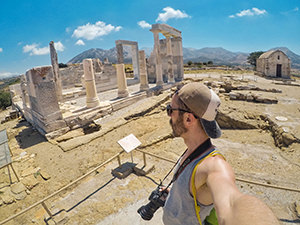
Located in Gyroulas, near the village of Sangri, this place had a religious purpose since the Bronze Age! The Mycenaean Civilization celebrated the cult of the gods in the open air. Then that same ruler Lygdamis ordered the building of the all-marble temple in the 6th century, as a rehearsal for the Parthenon in the Athenian Acropolis. The magnificent edifice was dedicated to Demeter, the ancient goddess of grain, so she would protect the farmers and care for the fertility of Naxos land. It even had the pits where vegetable juices would be sacrificed to please her.
When Christianity took over the command, Demeter’s Temple faced the same destiny as Apollo’s one. Aiming to erase paganism, Christians demolished the archaic temple. They built their own basilica on the same site, with the same stone. But as in that Biblical proverb, “Live by the sword, die by the sword”… The Arabian invaders demolished the church. The German archeologists were the ones who rebuilt it in 1977.
The Temple of Demeter is an excellent place to explore how religious powers have changed throughout history. One can see it on the very archeological site but also learn more at the next-door Archeological Museum of Gyroulas. The small exhibition displays parts of the interior, ceramics, statues, and other found objects. The entrance is included in the 4-Euro ticket price.
6. Cycle to the Sanctuary of Iria
Another predecessor of the Parthenon is the Sanctuary of Iria, found in 1982. This peculiar place had a religious character from the 14th century BC until today.
The archeologists actually identified four successive buildings plus a Christian basilica on the site, showing the uninterrupted history of worship.
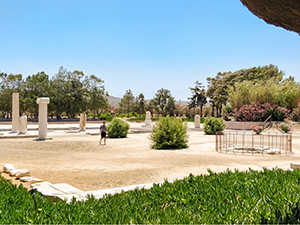
After an open-air cult in the Mycenaean times (1300-1100 BC), the first temple was built around 800 BC. But the flooding of the nearby river Byblos destroyed it. Not an unusual event here, as it happened in 2004 too, after the excavation of the Archeological Park.
The sanctuary whose remains, in the form of several columns, we see today was built in 590-570 BC. The temple of Iria is considered to be the birthplace of the Ionic style.
Besides being important in the history of architecture, this temple has roots in the traditions of the area. It was dedicated to Dionysus, the adored god of wine and partying. Even today, there are vines growing on the sanctuary grounds.
The location of the Temple of Dionysus is in Iria (sometimes spelled Yria), close to Glinado Village, just four kilometers from Chora. It is an interesting stop if you’re heading for the beach of Agia Anna by bike, for instance. The entrance to the temple grounds is free and one of the best things to do in Naxos for all archeology fans.
7. Visit Naxos churches
Besides ancient temples, Naxos is dotted with notable churches that should get onto your itinerary. There are at least 5 Naxos churches you should consider including in your own list of the best things to do in Naxos.
Panagia Drosiani
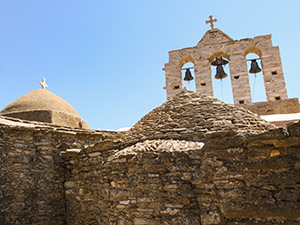
On the road between Chalkio (Halki) and the village of Moni, the stone church of Panagia Drosiani was built in the 6th century. It is the oldest Christian church on Naxos and one of the oldest ones in the Balkans. This Byzantine church is dedicated to the Virgin Mary of the rain who allegedly ended the times of drought on the island. Panagia Drosiani has very well-preserved murals of Jesus Christ, his mother, and other saints.
Agia Kyriaki
Located in Apeiranthos, this church has some unique frescoes from the 8th and 9th centuries. The restoration of the wall paintings secured Agia Kyriaki a prestigious EU Prize for Cultural Heritage in 2018 – the Europa Nostra Award.
Agios Georgios Diasoritis
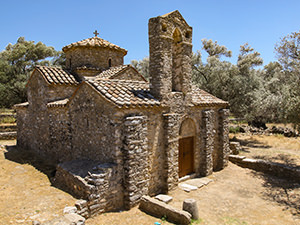
Ten-minute walk away from Chalkio, the Byzantine Church of Saint George Diasoritis stands out in the idyllic surroundings. Its walls were built in the 11th century. They decorated them with elaborate paintings of Saint George, Second Coming, etc.
Agios Mamas
Dating back to the 9th century, Agios Mamas set in the green valley is just a short hike away from the village of Potamia. The chapel dedicated to the patron saint of the shepherds was originally a Greek Orthodox cathedral. At the beginning of the 13th century, it was converted into a Catholic church. There are interesting frescoes and sculptures kept inside, away from the public eye.
Stavros Keramotis
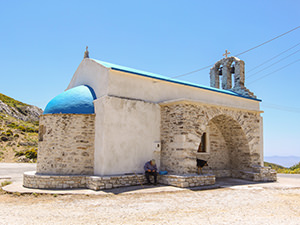
Located at the largest junction of the rural roads in Naxos, Stavros Keramotis is on this list mainly because of the views. It is the only place where one can see the sea on both sides of the island. The small whitewashed church is dedicated to the Exaltation of the Holy Cross. It was the only church from this list whose doors were actually open when I arrived.
8. Hike to Zeus Cave
Besides heavenly beaches and heaven-aspiring houses of worship, Naxos is also a hiking paradise! It has many tempting treks, but the mountainous village of Filoti is the starting point of its most famous hike – the one to the Zeus Cave!
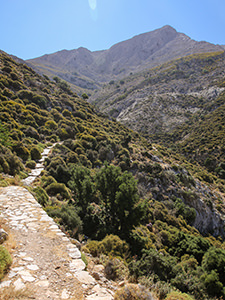
Instead of walking all the way from Filoti, drive towards the Aria Spring and start hiking there! You cannot miss it; it is a dead-end street. The road also has a dead side, if I can call it like that. Driving by the daunting cliff with no guardrails is rather ominous. At the end of the road, you will see the forbidden-parking sign. Most people park their cars here. Because – where else?
From Aria Spring (Fontaine d’Aria on Google Maps), a place to refill your water bottle, continue uphill after the doors you should close behind. I assume this is for controlling the movement of goats you will probably encounter twenty minutes later, just before the Zeus cave.
Mount Zas grotto – the hiding place of god and shepherds
The cave will appear on your left-hand side. It brings a welcoming protection from the sun, especially if you didn’t start your climb in the early morning. One doesn’t need to be the shepherd or the farmer of the past to call it a sanctuary.
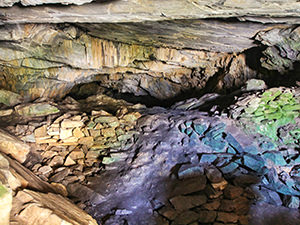
Zeus, the ruler of the Olymp gods, spent his childhood in this very cave, the myth says. Well, there is one in Crete that is also priding itself as an authentic hideaway of the little god. His father Cronos swallowed his children as soon as they were born, afraid of the prophecy that one of them would overthrow him. The mother Rhea hid Zeus in a cave and he grew up hiding in the mountain. Eventually, he did fulfill the prophecy and became the king of gods.
If you have good stamina, you can continue climbing for another hour to the top of Mount Zas, named after this divine survivor. At 1004 meters, it is the highest peak of not only Naxos but of all Cycladic archipelago. The summit provides great panoramic views.
9. See the impressive Naxos Marmor
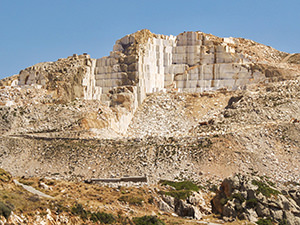
Ancient Greece is not only the place of origin for the word ‘marble’, but also home to some of the finest type of this shining stone on the planet. The people of Naxos were the pioneers of marble; they introduced the broad use of the noble material in architecture and sculpture. The temples and statues on this list were all built of Naxian marble, white marble with the largest crystal grains on Earth!
The first time I had an opportunity to explore this precious stone up close was at the Delphi Archeological Museum. The Sphinx of Naxos displayed there is an impressive 2-meter tall statue that stood on the top of a 10-meter tall column in this famous religious center of ancient Greece.
Read more about Delphi, the center of the antic world here!
If you type ‘Naxos Marmor’ in Google Maps, it will point you to a quarry near the village of Kinidaros, the modern-day center of Naxos marble mining. With precisely cut-out cuboid blocks of stone, the scenery looks surreal. It resembles an otherworldly place where Superman might’ve been growing up. Then again, he did, didn’t he? Except that he was called Zeus in this story.
10. Find Naxos Kouros statues in Melanes and Apollonas
The ancient marble quarries in Naxos were located near Melanes and Apollonas. These are the places where some of the remnants of the island’s glorious mining past still lay as witnesses.
They call them Kouroi (Kouros in the singular, literally meaning ‘beautiful man’). These ancient Greek freestanding monumental sculptures are meant to be the epitomes of the captivating beauty of young nude men. Some of these unfinished, roughly formed statues lay on the Naxos ground, abandoned due to the probable breakage that happened in transport.
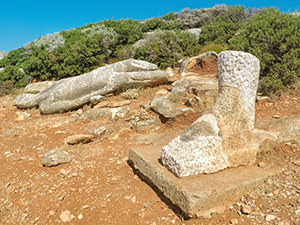
Close to the village of Melanes in Central Naxos, there are two incomplete Kouroi statues. Kouros of Flerio lays in a shaded garden, tucked under a tree. Kouros of Faranghi (or Kouros of Potamia) is just meters away from where they cut out the stone. These oversized men (about 5 meters tall, and weighing above 5 tons each) are in a typical archaic, frontal, still position. They both date to the 6th century BC and someone possibly cursed them with a “Break a leg” good wish.
In Northern Naxos, the stonemasons abandoned another impressive marble sculpture. Kouros of Apollonas, named after a village it still lies by, does not follow the Kouros rules. It has more distinctive facial features than those in Melanes. Actually, it seems to depict an older man (some call it the Colossus of Dionysus)! Additionally, instead of still arms close to the body, its right arm would have been stretched out. Kouros of Apollonas is also much bigger than the fellows in Melanes; it is 10.5 meters in length and weighs about 80 tons!
Admission to both Kouros graveyards is free, as long as you can find them. Some people tend to miss the signposts.
11. Explore the museums of Apeiranthos
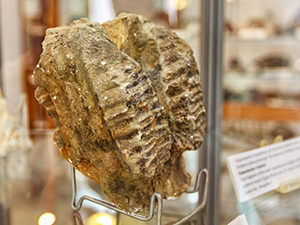
If you want to learn more about Naxian marble, other marble, as well as other types of rocks, a small village on the slopes of Fanari Mountain is the place to go. In the central street of Apeiranthos (or Apiranthos), one can find marble stairs. But the true gems are at the Geological Museum! This place exhibits rocks, meteorites, and fossils, some as old as 70,000 years! For science nerds, visiting this museum is one of the best things to do in Naxos!
The charming village of barely one thousand citizens has an astonishing number of museums – five of them! Just above the Geological Museum, there is the Folklore Museum which displays local traditions, furniture, clothes, tools, instruments, etc. Another floor up, the Visual Arts Museum exhibits paintings, sculptures, and other artworks of the village’s many artists.
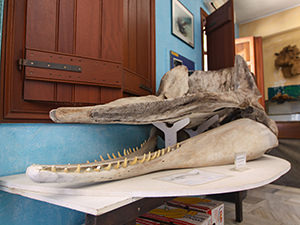
Natural History Museum has its own little room on the main road. Here, one can find skeletons of dolphins, the skull of a sperm whale, the shell of a turtle, snakes in formaldehyde, as well as a large flora collection.
Apeiranthos Archeological Museum exhibits the findings from the excavations in Naxos. It’s a one-room museum, but unlike the other four on this list, this one charges 3 Euros for the entrance.
With nice artistic workshops, charming cafés, and restaurant terraces, Apeiranthos is an ideal break from the exhaustion of the island exploring.
12. Climb to the Kastro of Naxos
Kastro of Naxos is the castle on the top of the hill of Naxos Chora. Marco II Sanudo, the Venetian Duke of the Archipelago, erected this citadel at the beginning of the 13th century. It was the center of political power dominating the Cyclades for three centuries.
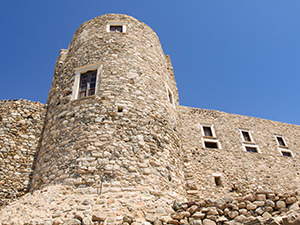
The medieval walls, composed of houses that were built there, still stand above Naxos Old Town. Inside, there are narrow streets, quiet squares filled with flowers and cats, Venetian mansions, churches, monasteries, and museums. It’s a calming area to get away from the Naxos sun and winds and enjoy the stroll among cafés, galleries, and terraces with picture-perfect views.
Look for the marble taken from the Temple of Apollo, used in the construction of the castle! It is a reminder of the constant recycling character of history. The castle built above the remains of the ancient acropolis is yet another addition to the ode of temporality on Naxos Island. Only the pieces of marble are strong enough to survive the ideas of those who believed they were building eternal monuments.
Chora’s Kastro is sometimes called Kato Kastro (or Lower Castle), in order to distinguish it from the Apano Kastro (Upper Castle), the fortification located on the hill above the village of Potamia. This construction project of the same duke never became a real settlement.
13. Visit the Venetian towers of Naxos
Besides Chora’s Kastro, Venetians built castles and towers strategically dotted over the entire Naxos territory. They were a protective shield against the pirates and had a special alarm system when one of them would get under attack. They would lit a large fire on the roof and, as in a domino effect, the neighboring towers would follow, quickly alarming all Venetian families on the island. Talk about the medieval version of WhatsApp!
You could visit many buildings from the Middle Ages while exploring the island. Only six of the most interesting Venetian towers entered our list of the best things to do in Naxos.
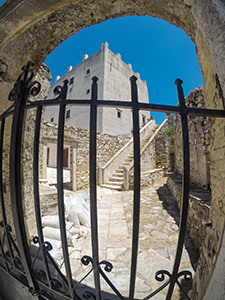
Fragopoulos Della Rocca Tower
Dating back to the 14th century, Fragopoulos Della Rocca Tower in Kourounochori is one of the oldest fortified towers on Naxos. It is also a place where a future Duke killed his predecessor.
Barozzi-Gratsia Tower
The same as Fragopoulos, the 17th-century Barozzi-Gratsia Tower in Chalkio has strong walls that are equipped with ‘murder holes’. They were designed to distract unwanted visitors – with scalding water!
Tower of Agia
The Tower of Agia, just before the village of Apollonas, was also built in the 17th century. It was the summer house for the rich Kokkoi family.
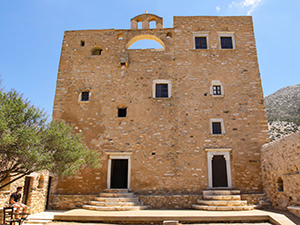
Bazeos Tower
Bazeos Tower served as a monastery and today, it is a private cultural center hosting exhibitions, concerts, and other events.
Bellonia Tower
Bellonia Tower in Galanado is interesting because of the Church of St. John standing next to it. It has a double arch, with a separate Catholic and Orthodox altar, one of the Venetian diplomatic attempts.
Tower of Glezos
The Tower of Glezos stands on the northwestern gate of the Kastro of Naxos and is the only round tower on the island. It was home to the last generation of Dukes.
14. Explore the abandoned hotel in Alyko
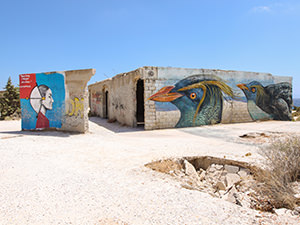
On Alyko promontory, right above some of the most beautiful Naxos beaches (remember the recommendation of the best things to do in Naxos no. 1?), a skeleton of a hotel stands still. Abandoned some six decades ago, never to welcome guests to its rooms with a sea view, the crumbling building is frozen in time.
The ghost hotel turns heads only of beachgoers in need of shade, avid urban explorers excited by the architecture of the past, and street artists always looking for a new canvas.
They are an unexpected finding, the ambitious murals trying to inject some new beauty and meaning into this concrete monument to a failed business investment.
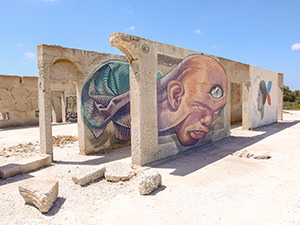
Okay, some of these can-equipped visitors leave just uncreative scribbles on the decaying building. But then there are true artists too, such as Wild Drawing (aka WD), who make the urban exploring of this Naxos hotel truly worthwhile.
This Bali-born Greek immigrant delivered many intriguing works to the outer walls of his new country, and we are happy to see that Alyko on Naxos often gets onto his summer itineraries. WD’s large murals that love to play with the environment in almost 3D realism, give a special value to the urbex adventure in Alyko’s empty hotel shell.
If this abandoned hotel project did anything for the tourism of Alyko, it brought the asphalt closer to the beaches one would need a car to explore anyway. The unexpected outcome of this architectural failure was that the dead-end street has ended up in – street art.
15. Eat Greek at To Elliniko
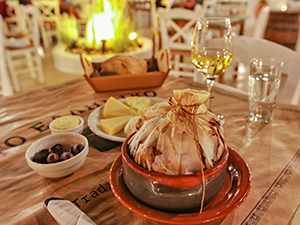
Naxos potatoes and cheeses are the founding stones of the island’s cuisine. To try these famous local ingredients, I visited the traditional kitchen of one of the best restaurants in Naxos. Eating local is, after all, one of the best things to do in Naxos, the most fertile Cycladic island.
To Elliniko literally means The Greek, and it delivers exactly the promised authenticity. The secret weapon in this family-run restaurant is mother Katerina who cooks with love and meraki (a Greek word describing passion, devotion, and leaving a piece of oneself in delivered work). Since 2008, the children of the Antoniou family have served the dishes from mom’s kitchen, while one of them, Giannis, continues to run the restaurant after Mixalis, the father of the family.
Behind the simple pot on the restaurant sign, lies equally simple homemade food. A starter woke up my stomach. It was a delicious infamous cheese platter with Naxos graviera, kefalotiri, and sour soft cheese!
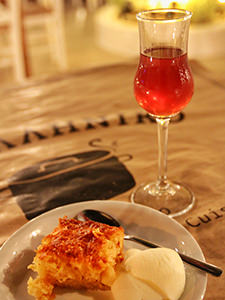
The cheese, together with potatoes and vegetables, appeared in Kleftiko too. This slow-roasted baby goat dish is a Hellenic classic. Paired with Sauvignon Blanc and wrapped like a present, it was truly rewarding! Supposedly it was named after Klepths, the Greek bandits who would steal lambs and cook them in the underground pits to not draw attention. After trying this mouthwatering meal where meat was melting off of the bone, I could totally understand what made these guys become kleptomaniacs.
My dinner at To Elliniko finished with an orange cake and ice cream, and mom’s raki liqueur with pomegranate. In the outdoor setting of a garden centered around an old olive tree, and encircled by flowerpots, with approachable and friendly staff, it seemed like visiting an old friend’s house for dinner. The one you end up commenting on: “You guys should open your restaurant!”
16. Sweeten up your day in Chalkio

Once the capital of Naxos, Chalkio village (Halki) still rules the palates of its visitors. Come here for a treat or two!
At Dolce Vita, the charming retro-styled café/patisserie, life is sweet indeed. Surround yourself with old gramophones, black-and-white photographs, and wooden chests. Order portokalopita or orange pie, and you will lick your vintage plate clean!
For those who are old enough to drive, yet will not sit behind the wheel for this little excursion, the Vallindras Distillery is right next door. This is the central production place for kitron, Naxos’ own liqueur, produced from the leaves of the autochthonous local citrus.
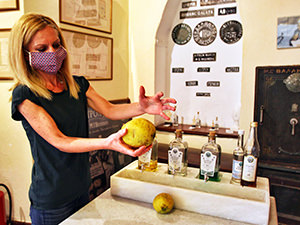
The fruit of kitron, resembling a lemon on steroids, can grow up to two kilograms each but is good mainly for making jams. The leaves, however, end up in this 96 % alcoholic beverage, in three differently colored varieties (from the lightest green, via the balanced transparent one, and yellow being the strongest).
The Vallindras family has been producing kitron liqueur since 1986, and you can try it after a little tour of this alcoholic lab/museum.
17. Buy some pots by the road
When driving from the southeastern Naxos coast towards Chalkio, make sure to stop by the road in the Damalas area. You can hardly miss the spot, as both the house facade and the parking lot are tricked up with an enormous quantity of pots of various sizes, shapes, and colors. Besides this colorful exhibition place that turns heads on the main road, the same family owns another workshop in Damalas village itself.
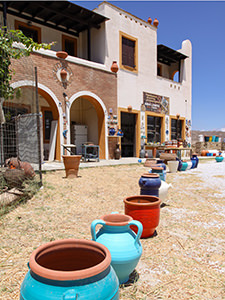
Limpertas Manolis Pottery is a traditional pottery workshop in operation since 1937. On two locations, descendants of the fourth generation of potters from the island of Sifnos, produce both functional and decorative clay products.
Since their grandfather Chrysos brought craftsmanship to Naxos in the 1870s, the technology might have advanced a bit, but artistic endeavors remained the same. Through passing the knowledge and secrets of the trade from one generation to another, the family business is booming.
Enter this clay wonderland, and lose your gaze among the thousands of cups, bowls, vases, jars, figurines, and fridge magnets! You might get a quick lesson in the production processes, as well as choose a special Cycladic souvenir to bring home from Naxos!
17 best things to do in Naxos – Conclusion
With the highest mountain of the Cyclades, Naxos is the greenest island in this Greek archipelago. Mountains trap clouds, clouds produce water, and water makes plants and trees grow. This results in more bearable hikes and possible shade just by the beach, as well as more productive agriculture that triumphs on the plates and in the glasses of Naxos restaurants.
Whether you climb up the mountain home of Zeus, dive deep into the world of Poseidon, or surrender to the decadent feasts of Dionysus, Naxos is a place of divine experiences
Even if it is the center of the Cyclades, Naxos Island attracts fewer tourists, and one can explore its many archeological sites, medieval castles, churches, museums, and charming mountainous and seaside villages without the feeling of a mass-tourism rush.
Whether you climb up the mountain home of Zeus, dive deep into the world of Poseidon, or surrender to the decadent feasts of Dionysus, Naxos is a place of divine experiences. It is a destination where one can appreciate the beauty of the land, as well as its gifts, from food to marble.
Naxos integrates the richness of culture, the power of history, and the intrigue of mystery. Something sacred, whether one believes in God(s) or not. In true holidays, this island fights well to explain the ‘holly’ part.
Did you like this travel guide to the best things to do in Naxos?
Pin the article and start planning your Naxos Island escape!
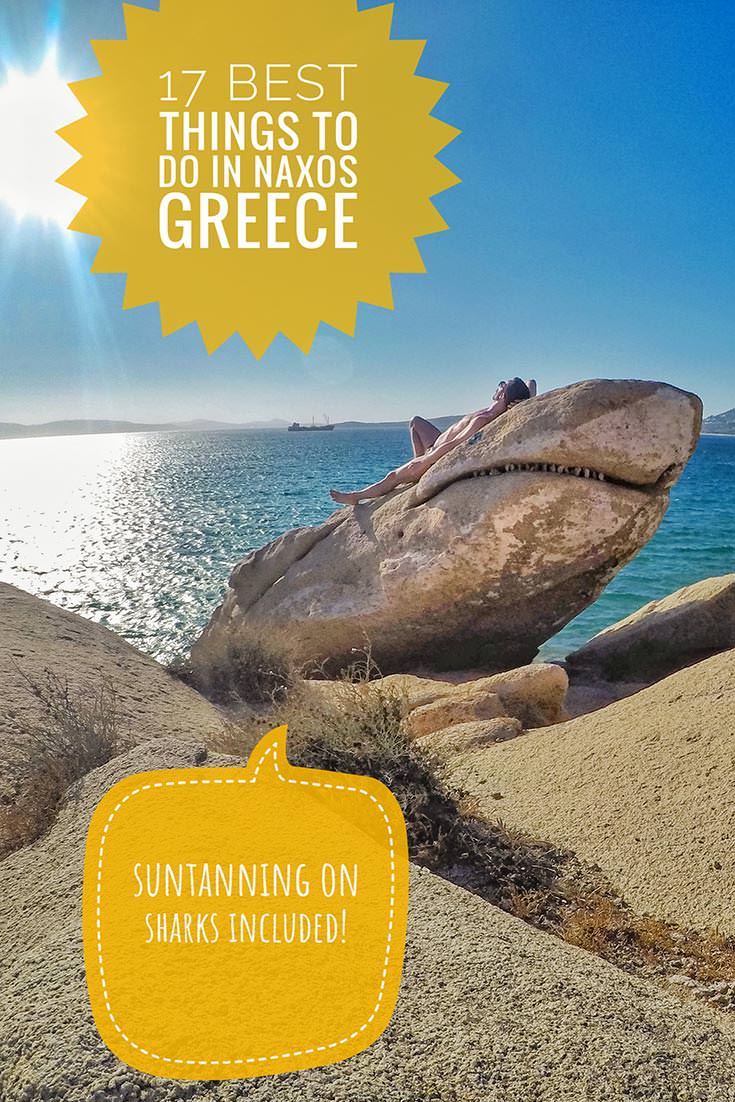
Before booking your trip to Naxos…
How many days do you need in Naxos?
After earlier two and three-day visits, on the most recent trip, I stayed four nights in Naxos and I still underestimated what the island has to give! If you like what you’ve read here, I advise you to extend your trip to a week. After all, one needs to set a human tempo for any holiday. With so many beaches the island is rightfully proud of, one has to tune down the exploring spirit at some point, and leave enough time to just enjoy the seaside and essentially do nothing.
What is the best area to stay in Naxos?
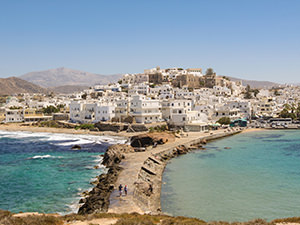
Most of the island’s visitors stay in Chora or on the southwestern coast, depending on the type of Naxos holidays they are looking for. Those who want to be in the center of the buzz and close to the port will opt for Naxos Town, and the others who prefer being next to the swimmable beaches will look for their Naxos accommodation in Plaka, Agia Anna, or Agios Prokopios.
Whether you’re looking for the most affordable or splurge option, you will find the best place to stay in Naxos here.
Getting to Naxos
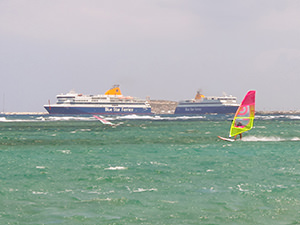
The most typical way of arriving in Naxos is by ferry. If you’re traveling from Athens to Naxos, you can catch the ferry in Piraeus or in Rafina. There are different operators who will bring you to the island at varying speeds and prices, but typically you should be there in less than 6 hours. Typically Blue Star Ferries offers the most economical transfer to Naxos.
Naxos is also well-connected with other islands such as Paros, Mykonos, Santorini, Syros, Crete, Milos, Ios, Amorgos, Koufonisia, etc.
I typically check ferry options on the openseas.gr website and buy them in any port agency. Book them in advance for the best prices! Even in the times of pandemic, the connections could sell out (which I actually experienced once), because boats travel with reduced capacities. So don’t rely on the idea that people are traveling less these days, and buy your ticket on time!
Can you fly directly to Naxos?
Naxos Airport “Apollon” is not the busiest one, but it is connected with Athens. If you’re looking for a quick 30-minute flight, check the offers of Aegean Airlines, Olympic Air, or Sky Express.
How do you get around Naxos?
While there are bus connections between the main island points (which could suffice if all you want is maybe get from Chora to the beach and back), for true exploration of Naxos one should rent a car. It is after all the largest island in the Cyclades and with 430 square kilometers of tempting content, having a vehicle at your disposal is a true benefit.

I warmly recommend renting your car at Fun Car & Rides agency. They have an office just at Naxos port where you disembark the ferry, making the pick-up and drop-off rather simple. Even the smallest car in their fleet such as Fiat Panda will serve you well enough to bring you to the most elevated parts of the island. And with their roadside assistance, there is nothing to worry about! Plus, the staff will not only provide Naxos maps and suggestions of things to do in Naxos. They will also bring a smile to your face in the process! The choice of the company’s name was indeed appropriate!
Things to do in Naxos and Paros – which one is better?
Is Naxos or Paros better? After repeated visits to both islands, I would say that Naxos is my favorite. Simply, there is a greater diversity of things to do in Naxos. It constantly invites you to check what’s behind the next corner! That being said, Paros does have its indisputable charm that even Hollywood stars cannot resist. The islands are neighbors, and why would you even consider not going to both? For Paros’ travelers, you might find useful our guide to Naoussa with the top 10 things to do there.
Disclosure: My scuba diving lesson with Blue Fin Divers, rent-a-car service at Fun Car & Rides, as well as dinner at To Elliniko, were complimentary, but all opinions are my own. Also, this post contains affiliate links, which means if you click on them and make a purchase, Pipeaway might make a small commission, at no additional cost to you. Thank you for supporting our work!

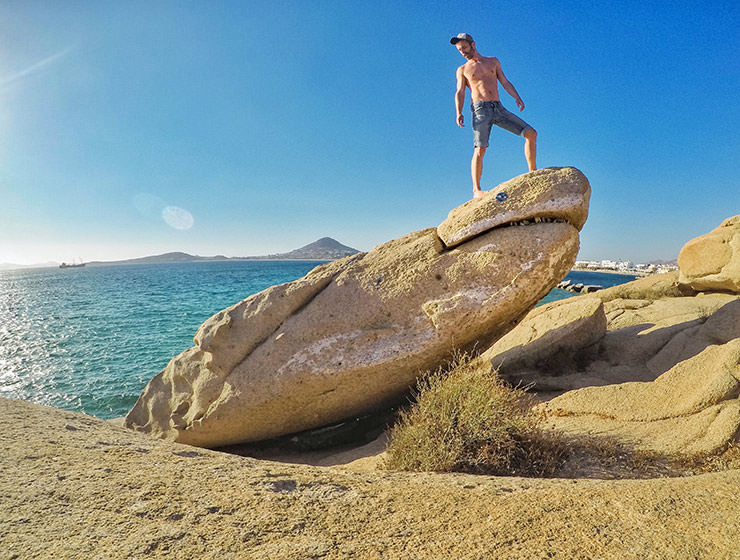

I would definitely visit all the historic places in Naxos. But still, that Agios Prokopios Beach looks gorgeous, just my cup of tea. 🙂
Nice post, you covered it all. <3
Thanks, Danijela!
Yes, for fans of history, the real one and the one wrapped in legends, Naxos offers plenty of places to explore. And it’s true that it’s nice to be able to take a dip on one of its beaches in between!
Looks amazing i’d love to visit Naxos someday, I’ve only heard good things about it. Thanks for sharing!
You’re welcome, Matthew! Enjoy your travels!
Naxos looks just gorgeous! I’m supposed to be in Athens next summer (knock on wood), so I might just take that ferry you mentioned from Piraeus. I love history, food, and beaches so this sounds like my kind of island!
Thanks for your comment, Carrie Ann!
If history, food and beaches are your travel priorities, Naxos will certainly not disappoint! Let me know how did your trip go! I hope these tips on things to do in Naxos will help your planning!
Loved it here! Your recommendations are spot on!
Thanks, Alexandra!
I’m glad we share the same feeling about Naxos!